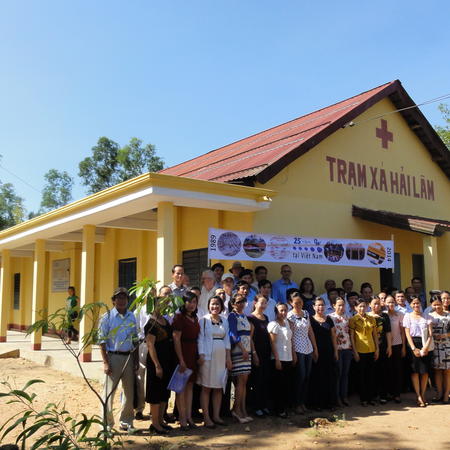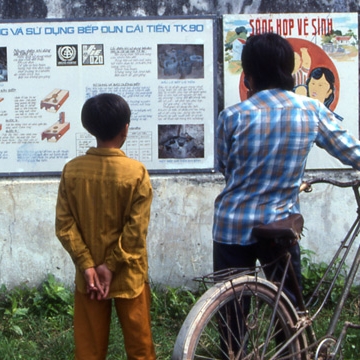- English
- Français
- Tiếng Việt
Myanmar

Support to rural communities for the cyclone rstsiant hosues and schools after Cyclone Nargis in 2008 - 2010, Myanmar/Burma
Before Nargis, very little attention was paid to disaster risk reduction. In the complex initial rehabilitation process after the cyclone DRR has not featured high on the priority list. However, it is clear that there is both a need and public interest to see how buildings and communities can be made safe from future disasters, and this extends beyond the scope of cyclones and flooding, other regions being affected by earthquakes as well.
Since 2008 DWF has collaborated with the Save the Children Alliance, Myanmar, using DWF experience in Vietnam to develop local knowledge about cyclone resistant construction techniques in the Irrawaddy delta, through community workshops and the retrofitting of schools as a public demonstration of techniques that can be used by the community. Phase 1: October 2008 – March 2009/ Phase 2 through to mid 2010. A team of Myanmar engineers travelled to the DWF office in Vietnam for training in November 2008, and the technical assistance for the project is partly provided by the DWF Vietnam team. Save the Children Alliance provides the funding and all institutional, administrative and logistical support.
The programme is based on the application of DWF’s ten key principles of cyclone resistant construction, tested over the past 20 years by DWF in Viet Nam, and applied no in Myanmar on the schools. These generic principles of safe construction apply to all types of rural building, schools and houses included.
Starting in October 2008 the project worked in cyclone affected townships in Yangon and the Irrawaddy Delta regions. The programme operated in groups of villages, selected on the basis that they each have a school that has been repaired or rebuilt after Cyclone Nargis damaged or destroyed it. In the immediate aftermath schools were repaired but not made to resist future cyclones and associated flooding. The project uses the strengthening of schools as an opportunity to develop disaster risk reduction techniques in the community.
In each group of villages, the project organizes a workshop open to the public, but focused on builders and leaders in the community. Participants assess why buildings are damaged, and what steps can be taken to make them storm and flood resistant. This is followed by practical work on the school that is to be strengthened to familiarize participants with the applied strengthening techniques. Once materials are available, the school is then strengthened by local builders. On completion, the strengthened school is opened to the public so that the work that has been done can be explained and appreciated. Children will also learn about methods to improve safety in their communities. This will initially be carried out through awareness raising about safe construction techniques in their school. Indirectly, the project aims to help families see how their own homes can be also be strengthened with the same basic principles of cyclone resistant strengthening.
The initial workshops in the Phase 1 in which 44 schools have been strengthened show that there is great interest in the programme, highlighted by the fact people are coming from other villages that do not have a school that will be strengthened in the present programme. In addition on each school site a small bamboo frame structure is build as a childe friendly space but really aimed at parents who can see how the ten key principles of cyclone resistant can be applied to timber frame, brick, reinforced concrete and bamboo structures.
In 2009 the DWF lead activities expanded to cover Save the Children shlert projedt ans wider awareness rsinng in villages about safer construction:
Safer Construction Awareness Campaign :DWF proposed and designed the Safer House Awareness Campaign with Save the Children staff in Myanmar. The Campaign aimed at the villages that were involved in the Safer Schools project, and involved children and adults in community awareness raising using demonstration of strengthening on one or two existing houses in each village, using existing and new posters about safer construction, and putting on a play by children adapted from DWF Viet Nam – ‘the Stubborn Builder’ who will not reinforce his house. Field activities in 2010 in 96 villages.
Middle Island Shelter project, Myanmar:DWF guided the Save the Children Alliance, Myanmar on a project for the construction of 533 new and safer houses around the town of Deedugone, Middle Island located in the South West tip of the Myanmar delta region. The framed houses, with bamboo mat walls and floors and thatched roofing incorporate eight of the ten key points of cyclone resistant construction. DWF undertook multiple monitoring missions. Completion in 2010 including the project evaluation.
Hlaing Bone Shelter project, Myanmar :DWF assisted and guided the Save the Children Alliance, Myanmar on a project for the construction of 700 new and safer houses and the strengthening of a further 150 houses around the town of Hlaing Bone in the in the centre of the Myanmar delta region. The framed houses, with bamboo mat walls and floors and thatched roofing incorporate eight of the ten key points of cyclone resistant construction. DWF undertook multiple monitoring missions. Completion in 2010.
Project development for child lead safer construction programmes in the Delta area and Rakhine State with Save the Children in 2010 & 2011.











